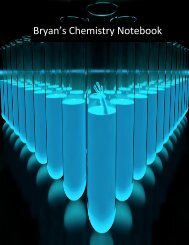Create successful ePaper yourself
Turn your PDF publications into a flip-book with our unique Google optimized e-Paper software.
12 Which action will drive the reaction to the right?<br />
A heating the equilibrium mixture<br />
B adding water to the system<br />
C decreasing the oxygen concentration<br />
D increasing the system’s pressure<br />
Explanation: If one or more of the reactants is a gas then increasing pressure will effectively increase<br />
the concentration of the reactant molecules and speed up the reaction. So, for gaseous reactants<br />
only, pressure is essentially a concentration factor. Increasing pressure has virtually no effect on<br />
solids or solutions engaged in a chemical reaction. The particles are, therefore on average, closer<br />
together and collisions between the particles will occur more frequently.<br />
NO2(g) + CO(g) ⇄ NO(g) + CO2(g)<br />
13 The reaction shown above occurs inside a closed flask. What action will shift the reaction to the<br />
left?<br />
A pumping CO gas into the closed flask<br />
B raising the total pressure inside the flask<br />
C increasing the NO concentration in the flask<br />
D venting some CO2 gas from the flask<br />
<br />
Explanation: The reactants are favored which causes them to shift to left because there are no<br />
gases present which means no change. The equilibrium will move in such a way that the<br />
pressure increases again. It can do that by producing more gaseous molecules. In this case, the<br />
position of equilibrium will move towards the left-hand side of the reaction.<br />
NH4Cl(s) + heat ⇄ NH3(g) + HCl(g)<br />
14 What kind of change will shift the reaction above to the right to form more products?<br />
A a decrease in total pressure<br />
B an increase in the concentration of HCl<br />
C an increase in the pressure of NH3<br />
D a decrease in temperature<br />
Explanation: Increasing the temperature increases reaction rates because of the disproportionately<br />
large increase in the number of high energy collisions. It is only these collisions (possessing at least<br />
the activation energy for the reaction) which result in a reaction. When you raise the temperature of a<br />
system, the molecules bounce around a lot more. They have more energy. When they bounce around<br />
more, they are more likely to collide. That fact means they are also more likely to combine. When you<br />
lower the temperature, the molecules are slower and collide less. That temperature drop lowers the<br />
rate of the reaction.<br />
15 In a sealed bottle that is half full of water, equilibrium will be attained when water molecules<br />
A cease to evaporate.<br />
B begin to condense.<br />
C are equal in number for both the liquid and the gas phase.<br />
D evaporate and condense at equal rates.<br />
Explanation: At equilibrium, the rate of forward reaction is equal to the rate of backward reaction.<br />
Therefore, when the rate of condensation will become equal to the rate of evaporation equilibrium is<br />
146




